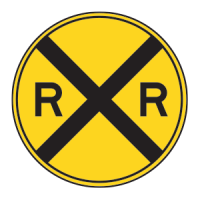
There will be a railroad crossing up ahead. A circular, bright yellow caution sign with a black "X" symbol and letters reading "RR." This sign is placed a few hundred feet in front of the tracks and warns drivers to slow down, look, listen, and get ready to stop when they approach the ways. If necessary, roll down one of the windows and pay close attention to an approaching train.
Signs that read "Hairpin Curve Ahead" alert drivers that the road is about to make a sharp turn known as a hairpin curve. These signs, which warn drivers of sharp curves ahead of time and help reduce the likelihood of accidents, are commonly posted along the sides of roads.
When it rains, the water that is already on the road causes the friction to decrease. When tires travel over a wet surface, the water fills in the little tiny pits that are on the road surface, which has the effect of effectively smoothing out the surface. Consequently, the average heat and friction generated are reduced, resulting in a character that is less grippy than when it is dry.
"No parking anytime" is a parking regulation that prohibits vehicles from parking in a specific area at any time, without exceptions. This regulation is typically indicated by signs or pavement markings that display the text "No parking anytime" or similar wording.
The purpose of the turn prohibition sign, known as the no-left turn sign, is to alert drivers that turning left is not permitted, thereby decreasing the likelihood that they will get into an accident. Typically located at intersections, stop signs, yield signs, and other locations where drivers intend to make a left turn.
HOSPITAL. A service sign illustration. These signs are square or rectangular and include white text or symbols on a blue background. They display where certain services are located.
"Look for detour signs and be prepared to make a turn" is a directive that advises drivers to watch for signs indicating a detour or alternative route and be ready to change their direction of travel accordingly.
"The road ahead gets slippery when wet" is a warning sign that indicates that the road surface can become hazardous and slippery when it's wet, such as during rainfall, snowfall, or after irrigation.
No Parking Anytime. According to the sign, motorists are not permitted to leave their vehicles parked on either side of the road during the week at any time. There will be no loading or unloading at any time. Along either side of the road, it is against the law to come to a stop to let passengers on or off the vehicle.
You can tell you are entering a work zone on the motorway by the orange construction signs. It's possible that the road is congested, a flagger is directing traffic, and equipment and workers are on or close to the roadway. Do not speed, and be ready to tackle all of these problems. To prevent a rear-end collision, maintain a safe gap between your car and the one in front of you.
When the traffic light at an intersection is red, drivers are not allowed to turn right by this sign. Before making the turn, you must wait for the light to turn green.
The right lane will end up ahead. When it is safe to do so, drivers currently in the right lane must merge into the left lane.
Unless otherwise indicated by posted signs, the speed limit in most states of the United States for school zones is between 25 and 40 kilometers per hour (15 and 25 miles per hour). Signs posted in school zones typically include a notice that reads "When children are present."
In most English-speaking countries, the following is the typical order in which the traffic lights change: When the red light is on, it indicates to drivers that they need to stop. When the green light comes on, the driver can either begin driving or continue driving. A yellow light means that the light will soon turn red, so drivers should come to a complete stop as soon as it is safe to do so.
Some automobiles are not built to maintain the speed of moving traffic. Road maintenance vehicles, farm tractors, and animal-drawn carts typically go at 25 mph or less. Vehicles driving slowly have an orange/red triangle on the back.
Guide signs, often called destination signs, have white text on green backgrounds. Along the route, guide signs identify sites of interest, alert you about intersecting roads, and assist in guiding you to cities and villages.